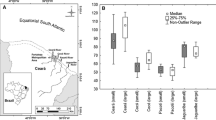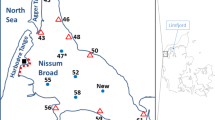Abstract
The Channel of Santa Cruz is a mangrove area in northeastern Brasil 40 km north of Recife. Until 1991 a chlor-alkali factory discharged large amounts of mercury into the main tributary of the channel, the Rio Botafogo. The objective of this study was to assess the potential of the mangrove oyster Crassostrea rhizophorae as a bioindicator for mercury in this area and to examine the influence of condition on mercury concentrations in the oysters. The investigation was carried out in the late rainy season (July to September) 1993, in the rainy season (April to June) 1994 and in the dry season (November/December) 1994. At 11 stations in the channel, mangrove oysters, surface sediments and suspended matter were sampled, representing different compartments of the system. The distribution of mercury in the Channel of Santa Cruz exhibited for all compartments the same distinct spatial pattern with maxima in the Rio Botafogo. Seasonal variations were small and revealed no clear tendencies. In addition, mangrove oysters were transplanted from more contaminated stations to less contaminated stations and vice versa. These experiments were designed to study the oysters' capability to adjust their mercury concentrations to a changing bioavailability of mercury. The transplantation experiments suggest that the oysters are capable to adjust to changing ambient mercury availability within a few months. The transplantation experiments also revealed the importance of condition changes on the mercury concentration of the oysters. This factor should not be ignored during pollution studies. However, condition had apparently no strong influence on the spatial or seasonal mercury variations of the oysters. The mangrove oyster is a suitable bioindicator for long-term changes in mercury availability.
Similar content being viewed by others
Author information
Authors and Affiliations
Additional information
Received: 20 August 1997 / Accepted: 15 January 1998
Rights and permissions
About this article
Cite this article
Meyer, U., Hagen, W. & Medeiros, C. Mercury in a northeastern Brazilian mangrove area, a case study: potential of the mangrove oyster Crassostrea rhizophorae as bioindicator for mercury. Marine Biology 131, 113–121 (1998). https://doi.org/10.1007/s002270050302
Issue Date:
DOI: https://doi.org/10.1007/s002270050302




